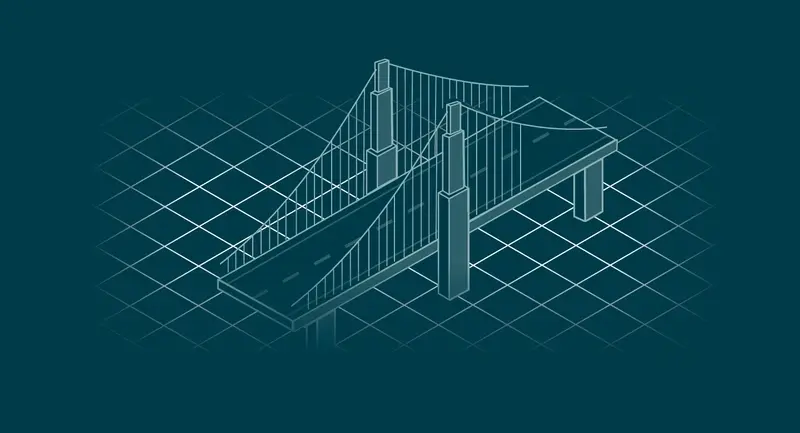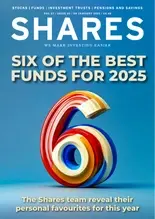
THIS IS AN ADVERTISING FEATURE
For roughly 80 years, rapid industrial production growth defined the U.S. economy. Starting in the early 2000s, however, the U.S. industrial production machine began a two-decade stagnation. But things are changing. Deglobalization and re-shoring are gaining momentum, and developed economies want to strengthen their supply chains. To mitigate economic and geopolitical risks, the U.S. plans to invest heavily in reconstructing and modernizing the country’s mechanisms for industrial production. We expect this renaissance to lead to greater infrastructure, more automation, and related investment opportunities.
Companies in the infrastructure space have generally reported strong earnings amid difficult operating conditions in recent years, primarily due to structurally high demand for construction across several key segments. Many of these companies have yet to recognize benefits from the hundreds of billions in federal and private funding that is barreling toward the space from the potentially powerful overlapping effects between the Infrastructure Investment and Jobs Act (IIJA), the Inflation Reduction Act (IRA), and the Creating Helpful Incentives to Produce Semiconductors (CHIPS) Act.
It's also important to note that infrastructure investment is an area of bipartisan support in the U.S. The 2024 election cycle creates uncertainty, but both parties have shown a willingness to spend on infrastructure, and the IIJA passed with relatively strong cross-party support in 2021.1 Although the IRA passed along party lines through the reconciliation process in 2022 and has been a target of Republicans, full repeal would likely be very difficult even in the event of a Republican sweep of the White House, Senate, and House. This is because IRA initiatives have benefitted Republican-led states significantly, resulting in job growth and private investment.
IIJA Rollout Continues, With Most Benefits Still to Come
In November 2023, the Biden Administration provided an update on the IIJA to mark the two-year anniversary of the bill’s passage. The Administration reported that $400 billion for more than 40,000 projects at the state level has been announced.2 This tally does not represent “shovel-ready” projects, as many projects remain in their planning stages with several more steps needed before construction can begin. Announced projects are likely an indication of where federally funded construction could occur. We expect the total thus far to represent only a subset of what is to come from the IIJA.
Still, many projects are moving forward already thanks to the law. Thus far, the IIJA helped launch 7,800 bridge repair projects, jumpstart renovation on 135,800 miles of roads, and fund 190 airport modernization efforts.3
On recent earnings calls, infrastructure development management teams highlighted the benefits coming from the IIJA. During engineering services company Jacobs Solutions’ fiscal Q4 2023 earnings call, management said that its IIJA-related transportation project pipeline grew 20% year-over-year.4 Also in the engineering space, Tetra Tech noted on its fiscal Q4 2023 earnings call that a large portion of added government project backlogs during the quarter were IIJA-related.5 Management also said that it expects additional revenues attributable to the IIJA to peak in late 2025 or early 2026.6
Infrastructure Is Drawing Attention and Dollars From the Private Sector
Along with the IIJA, the IRA and CHIPS Act are increasingly topics of conversation on earnings calls. The IRA and CHIPS Act provide various incentives to manufacture clean tech and semiconductors in the United States, which could present direct opportunities to domestic companies with the expertise to build out industrial capacity.
The IRA builds on provisions in the IIJA to support increased renewable energy generation, expand transmission capacity, and further electric vehicle (EV) adoption and charging network deployment. In our view, investments in these segments can directly and indirectly boost demand for construction services and equipment. For example, according to the Department of Energy, total transmission infrastructure capacity in the contiguous United States is expected to grow 57% between 2020 and 2035 due to support from the IRA and IIJA.7 This forecast compares to just 16% growth in a baseline scenario where neither bill was passed.
Federal spending is also encouraging the private sector to act. Since the CHIPS Act and IRA passed in August 2022, private funding for areas like semiconductors, clean power and equipment, and EVs and batteries totaled $577 billion as of November 2023.8 In this sense, the enormous top-line numbers for these bills actually understate the magnitude of funding that could impact the U.S. infrastructure space over the next several years.
Conclusion: Momentum Builds Around U.S. Infrastructure
The IIJA represents one of the most direct and substantial investments toward U.S. infrastructure in history. Also primed to stimulate the construction value chain are the IRA and CHIPS Act, particularly from the energy transition perspective. These historic investments remain in their early days in terms of impact, but they are already working together to drive positive sentiment toward the U.S. Infrastructure Development theme through 2024.
Related ETF: Global X U.S. Infrastructure Development UCITS ETF (PAVE)
The Global X U.S. Infrastructure Development UCITS ETF (PAVE) seeks to invest in companies that stand to benefit from a potential increase in infrastructure activity in the United States, including those involved in the production of raw materials, heavy equipment, engineering, and construction.
Capital at risk: The value of an investment in ETFs may go down as well as up and past performance is not a reliable indicator of future performance.
- White House. (2021, November 6). Fact Sheet: The Bipartisan Infrastructure Deal.
- The White House. (2023, November 9). FACT SHEET: Biden-Harris Administration Celebrates Historic Progress in Rebuilding America Ahead of Two-Year Anniversary of Bipartisan Infrastructure Law.
- Ibid.
- Jacobs Solutions, Inc. (2023, November 21). Q4 2023 Earnings Call.
- Tetra Tech, Inc. (2023, November 16). Q4 2023 Earnings Call.
- Ibid.
- U.S. Department of Energy. (2023, February). National Transmission Needs Study.
- The White House. (2023, November). Investing in America.
The Global X UCITS ETFs are regulated by the Central Bank of Ireland.
This is a marketing communication.
Please refer to the relevant prospectus, supplement, and the Key Information Document (“KID”) of the relevant UCITS ETFs before making any final investment decisions.
Investors should also refer to the section entitled “Risk Factors” in the relevant prospectus of the UCITS ETFs in advance of any investment decision for information on the risks associated with an investment in the UCITS ETFs, and for details on portfolio transparency. The relevant prospectus and KID for the UCITS ETFs are available in English at www.globalxetfs.eu/funds.
Investment in the UCITS ETFs concern the purchase of shares in the UCITS ETFs and not in a given underlying asset such as a building or shares of a company, as these are only the underlying assets that may be owned by the UCITS ETFs.
A UCITS ETF’s shares purchased on the secondary market cannot usually be sold directly back to a UCITS ETF. Investors must buy and sell shares on a secondary market with the assistance of an intermediary (e.g. a stockbroker) and may incur fees for doing so. In addition, investors may pay more than the current net asset value when buying shares and may receive less than the current net asset value when selling them. Changes in exchange rates may have an adverse effect on the value price or income of the UCITS ETF.
Past performance of a UCITS ETF does not predict future returns. Future performance is subject to taxation which depends on the personal situation of each investor, and which may change in the future. Neither past experience nor the current situation are necessarily accurate guides to the future growth in value or rate of return of a UCITS ETF.
Investment may be subject to sudden and large falls in value, and, if it is the case, the investor could lose the total value of the initial investment. Income may fluctuate in accordance with market conditions and taxation arrangements. The difference at any one time between the sale and repurchase price of a share in the UCITS ETF means that the investment should be viewed as medium term to long term.
Any investment in a UCITS ETF may lead to a financial loss. The value of an investment can reduce as well as increase and, therefore, the return on the investment will be variable.
Global X ETFs ICAV is an open-ended Irish collective asset management vehicle issuing under the terms of its prospectus and relevant supplements as approved by the Central Bank of Ireland and is the issuer of certain of the ETFs where stated.
Global X ETFs ICAV II is an open-ended Irish collective asset management vehicle issuing under the terms of its prospectus and relevant supplements as approved by the Central Bank of Ireland and is the issuer of certain of the ETFs where stated.
Communications issued in the European Union relating to Global X UCITS ETFs are issued by Global X Management Company (Europe) Limited (“GXM Europe”) acting in its capacity as management company of Global X ETFs ICAV. GXM Europe is authorised and regulated by the Central Bank of Ireland. GXM Europe is registered in Ireland with registration number 711633.
Communications issued in the United Kingdom and Switzerland relating to Global X UCITS ETFs are issued by Global X Management Company (UK) Limited (“GXM UK”), which is authorised and regulated by the Financial Conduct Authority. The registered office of GXM UK is 77 Coleman Street, London, EC2R 5BJ, UK. Information about GXM UK can be found on the Financial Services Register (register number 965081).
Information for Investors in Switzerland
This is an advertising document. The state of the origin of the fund is Ireland. In Switzerland, the representative is 1741 Fund Solutions AG, Burggraben 16, CH-9000 St.Gallen. The paying agent is Tellco AG, Bahnhofstrasse 4, 6430 Schwyz.
The prospectus, the key information documents or the key investor information documents, the articles of association as well as the annual and semi-annual reports may be obtained free of charge from the representative.
Past performance is no indication of current or future performance. The performance data do not take account of the commissions and costs incurred on the issue and redemption of units.




